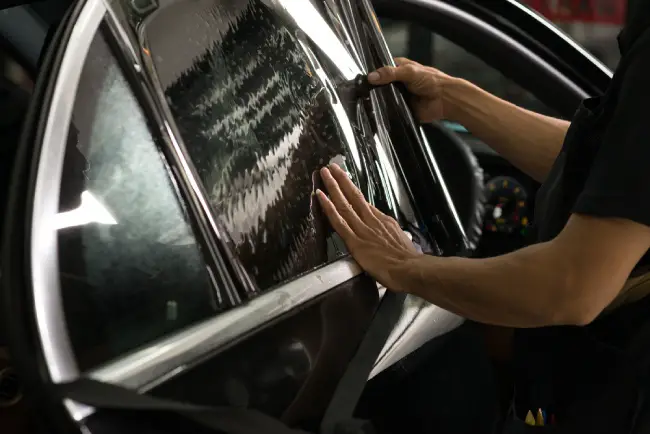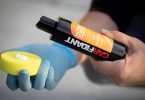People tint their car windows for a number of reasons. Window tints help you block glares, UV rays, infrared, and other light rays to provide safety, privacy, and temperature control. However, you just can’t use however dark shade you like on your car as there are some regulations regarding it.
Today we’re talking about the overall cost of different types of window tint, the regulations related to tinting your windows, and how you can tint your window yourself.
How Much Does It Cost to Tint Car Windows?

The short answer is, around $50-$1000. But this will depend on your vehicle type, the type of tint you want to use, and the number of windows you want to be tinted.
Let’s have a look at how much you’ll need to spend depending on the variables mentioned above.
By tint type
Dyed
This is the most affordable and popular option. The method involves applying several layers of dyed polyester film to absorb light and heat.
However, dyed tints don’t offer much protection from UV. UV will degrade the tint’s dye, causing it to fade away over time. Bubbling is also a common problem that comes with dyed tints. You’ll need to redo your tints comparatively more frequently.
It’ll cost you anywhere from $50-$600 depending on your car’s type and the number of windows.
Metalized
Also known as metallic tint, this method involves using metal particles to reflect heat, light, UV, and infrared. Aside from providing a more shiny chrome-like finish, metalized tints also reinforce the windows’ structure, making them more durable.
However, the metallic particles interfere with radio, Bluetooth, GPS, and cell phone signals. It also makes seeing through the glass from the outside almost impossible.
That’s why there are regulations about using this type of tint. Many states in the US have banned its use whereas other states have limitations on how reflective your window tints can be. It will cost you around $100-$800 depending on the level of reflection you want.
Hybrid
Hybrid tints are commonly referred to as the combination of metallic and dyed tints. Due to the regulations imposed on metalized tints, these hybrid tints provide less shine and interference. They provide better quality than standard dyes and will cost around $150-500.
Carbon
This type utilizes carbon fiber particles and provides superior protection against heat, UV, and other kinds of light without any interference. Carbon tinted windows can reduce the heat by up to 40% and don’t fade away over time. As a result, carbon tinting is expensive.
Despite being cheaper than ceramic tinting, carbon tinting performs close to it. However, they provide a matte finish on the outside, and many people don’t like the appearance that much. You’ll have to spend around $600-$800 to tint your car’s window with carbon particles.
Ceramic
This is the most expensive and effective form of window tinting as it can block more than 99% of UV rays. Your window won’t need to be as dark as other tinted windows and the temperature inside will reduce by almost half.
Additionally, these ceramic films are shatterproof, which will reinforce your window. The ceramic film contains non-metallic and non-conductive particles, so you’ll feel no interference. Ceramic tints don’t have so many regulations as metalized tints, and you can choose any level of darkness.
Ceramic tinting will set you back around $200-$1000.
By vehicle type
Sedans
Sedan cars can have up to 7 windows. If you want to tint just one of them, you’ll need around $50-100 depending on the quality and type of the tint. For tinting all the windows, you’ll need to pay around $250 for the cheapest tint and around $650 for the most expensive one.
Coupes
Coupes come with an extra bit of challenge. They can have up to 5 windows, but if the windows are curved or you have a steep rear window, you’ll need to pay more. On average, you’ll need to spend around $120-$450.
SUVs
The windows of an SUV are bigger and installed higher than other car windows. It also impacts the labor cost and the material used. As a result, expect a bill of around $450-$900 for tinting all of your 7 big SUV windows.
Trucks
For large vehicles like trucks, the price will largely depend on how much labor and time it takes to tint your windows. However, due to having fewer windows, it’ll cost significantly less than cars with more windows. You can get your truck’s windows tinted for about $300-$400.
Vans
Depending on the type of your van, and the number of windows your van has, you may need to pay anywhere between $100-$750 for tinting your van’s windows. Minivan-type van windows will cost less whereas cargo van, transport van, or conversion van windows may cost slightly more.
How Does Window Tint Installation Work?
As mentioned earlier, the basic job of your window tint is to block, absorb, and reflect some of the heat, UV, infrared, and glares so that you can enjoy some privacy and safety in a colder environment.
The pigments used in window tints are attached to the inside surface of your window. There are three measurements that will showcase how good your tint is in blocking, reflecting, and absorbing visible light.
They are named Visible Light Transmitted (VLT), Visible Light Reflected (VLR), and Visible Light Absorbed (VLA) respectively. If you want to know more about the process, here’s a video:
The legal limit
Due to safety concerns and the interference many window tints provide, there are limitations across many states on using window tints.
For example, in Illinois, the tint of your sedan has to allow more than 35% light to come inside (except windshields). In the case of an SUV/minivan, your front window tint needs to allow 50% light to pass through. Iowa, on the other hand, requires 70% light transparency on the front windows.
In some states like New Jersey and New Hampshire, it’s illegal to tint your front side windows. It would be wise to know about your local laws before darkening your windows. Otherwise, you’ll be subject to non-moving violation tickets.
Should You Tint Your Car Windows
People tint their windows for a variety of reasons. If you feel like the additional protection window tints provide is worth it, and your state regulations are maintained, by all means, go for it.
Window tints are not only for looks or privacy, but they also provide a bit of safety. As things inside the car are harder to see, you’ll be safe from theft or vandalism. Additionally, window tints will keep the temperature inside the car down.
However, one thing needs clarification. All the pricing mentioned here is subject to change. Contact your nearest tint shop for the exact price and the law about window tinting in your state.
Can you DIY?
Technically, you can tint your car windows by yourself. However, professional discretion is highly recommended, especially if you need to remove the previous tint before applying a new one. You’ll find a DIY tinting kit in your nearest tint shop for about a hundred dollars.
However, it’s a delicate task that can go wrong in so many ways. That’s why it’s better to rely on a professional. If you still want to know how you can tint your car’s window yourself, check this video out:
FAQs
1. What is the darkest legal window tint?
Ans: According to the 2022 California window tint laws, your front window and windshield tints have to have a 70% VLT (Visible Light Transmitted) rating. There are no restrictions on how dark your rear and back window tint can be.
2. Is Window Tint worth the money?
Ans: Yes, of course. The most important aspect of quality window tints is to block the UV rays coming from the sun. Overexposing to UV not only damages the car’s internal components but also can cause severe skin issues (including cancer).
3. Can you see at night with 20-tint?
Ans: Yes, you’ll be able to see at night through your 20-tint window. However, the tint will allow only 20% light to pass through and you’ll notice a remarkable difference from a non-tinted glass. It’ll take you some time to adjust yourself with a 20-tint glass.
4. What tint blocks the most heat?
Ans: If blocking the heat is your primary concern, carbon or infrared rejection films are the best options for you. These films will block infrared rays. As a result, no greenhouse effect will take place inside your car and the temperature will be cooler.
5. What is a Chameleon window tint?
Ans: It is a special type of window tint that appears to be changing color depending on your angle of view, weather, lighting, and temperature. The color-changing property resembles that of a chameleon and that’s why this tint is named such.









Leave a Comment